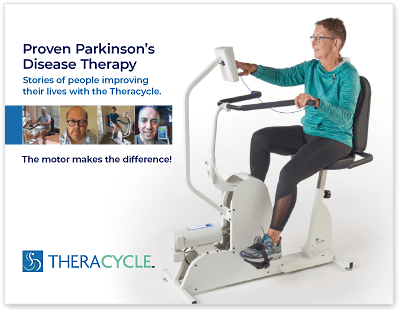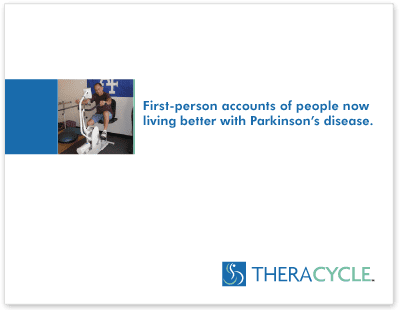- ›
- Stories
- ›
- Uncategorized
- ›
- The Impact of Forced Exercise on Motor Functions in Parkinson’s
Stories
The Impact of Forced Exercise on Motor Functions in Parkinson’s
A significant number of visitors to the Theracycle Blog have told us they want to learn more about “Forced Exercise” and how research has shown that “Forced Exercise” (FE) can improve motor function in Parkinson’s disease patients.
An overview of the initial FE research is found in the Abstract of the 2009 article written by J.L, Alberts, A.L. Ridgel & J.L. Vitek researchers at the Department of Biomedical Engineering of the Cleveland Clinic for their article published in the July-August 2009 issue of Neurorehabilitation and Neural Repair, the Journal of the American Society of Neurorehabilitation.

ABSTRACT
Forced, Not Voluntary, Exercise Improves Motor Function in Parkinson’s Disease Patients
Department of Biomedical Engineering, Cleveland Clinic, Cleveland, OH 44195, USA.
Ridgel AL, Vitek JL, Alberts JL.
January 08, 2009
Neurorehabil Neural Repair. 2009 Jul-Aug;23(6):600-8. Epub 2009 Jan 8.
BACKGROUND: Animal studies indicate forced exercise (FE) improves overall motor function in Parkinsonian rodents. Global improvements in motor function following voluntary exercise (VE) are not widely reported in human Parkinson’s disease (PD) patients. OBJECTIVE: The aim of this study was to compare the effects of VE and FE on PD symptoms, motor function, and bimanual dexterity. METHODS: Ten patients with mild to moderate PD were randomly assigned to complete 8 weeks of FE or VE. With the assistance of a trainer, patients in the FE group pedaled at a rate 30% greater than their preferred voluntary rate, whereas patients in the VE group pedaled at their preferred rate. Aerobic intensity for both groups was identical, 60% to 80% of their individualized training heart rate. RESULTS: Aerobic fitness improved for both groups. Following FE, Unified Parkinson’s Disease Rating Scale (UPDRS) motor scores improved 35%, whereas patients completing VE did not exhibit any improvement. The control and coordination of grasping forces during the performance of a functional bimanual dexterity task improved significantly for patients in the FE group, whereas no changes in motor performance were observed following VE. Improvements in clinical measures of rigidity and bradykinesia and biomechanical measures of bimanual dexterity were maintained 4 weeks after FE cessation. CONCLUSIONS: Aerobic fitness can be improved in PD patients following both VE and FE interventions. However, only FE results in significant improvements in motor function and bimanual dexterity. Biomechanical data indicate that FE leads to a shift in motor control strategy, from feedback to a greater reliance on feedforward processes, which suggests FE may be altering central motor control processes.
Click here to see the online Abstract of the article on the NNR website.







